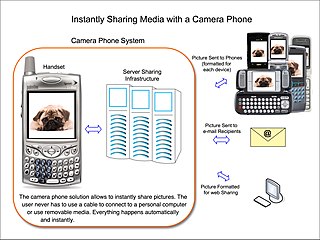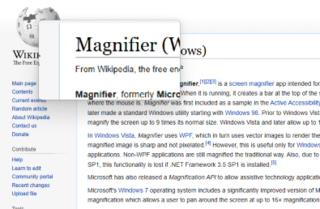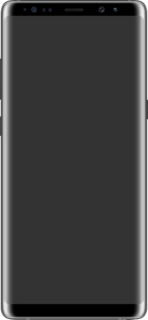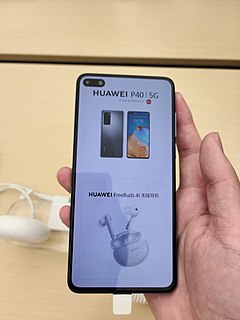
A digital camera is a camera that captures photographs in digital memory. Most cameras produced today are digital, largely replacing those that capture images on photographic film. While there are still dedicated digital cameras, many more cameras are now incorporated into mobile devices like smartphones, which can, among many other purposes, use their cameras to initiate live video-telephony and directly edit and upload images to others. High-end, high-definition dedicated cameras are still commonly used by professionals and those who desire to take higher-quality photographs.

A smartphone is a portable device that combines mobile telephone and computing functions into one unit. They are distinguished from feature phones by their stronger hardware capabilities and extensive mobile operating systems, which facilitate wider software, internet, and multimedia functionality, alongside core phone functions such as voice calls and text messaging. Smartphones typically contain a number of metal–oxide–semiconductor (MOS) integrated circuit (IC) chips, include various sensors that can be leveraged by pre-included and third-party software, and support wireless communications protocols.

A screen magnifier is software that interfaces with a computer's graphical output to present enlarged screen content. By enlarging part of a screen, people with visual impairments can better see words and images. This type of assistive technology is useful for people with some functional vision; people with visual impairments and little or no functional vision usually use a screen reader.

In optical engineering, the objective is the optical element that gathers light from the object being observed and focuses the light rays to produce a real image. Objectives can be a single lens or mirror, or combinations of several optical elements. They are used in microscopes, binoculars, telescopes, cameras, slide projectors, CD players and many other optical instruments. Objectives are also called object lenses, object glasses, or objective glasses.

Magnification is the process of enlarging the apparent size, not physical size, of something. This enlargement is quantified by a calculated number also called "magnification". When this number is less than one, it refers to a reduction in size, sometimes called minification or de-magnification.

A magnifying glass is a convex lens that is used to produce a magnified image of an object. The lens is usually mounted in a frame with a handle. A magnifying glass can be used to focus light, such as to concentrate the sun's radiation to create a hot spot at the focus for fire starting.

A camera phone is a mobile phone which is able to capture photographs and often record video using one or more built-in digital cameras. It can also send the resulting image wirelessly and conveniently. The first color commercial camera phone was the Kyocera Visual Phone VP-210, released in Japan in May 1999.

Digital zoom is a method of decreasing the precise angle of view of a digital photograph or video image. It is accomplished by cropping an image down to an area with the same aspect ratio as the original, and scaling the image up to the dimensions of the original. The camera's optics are not adjusted. It is accomplished electronically, so no optical resolution is gained. Digital zooming may be enhanced by computationally expensive algorithms which sometimes involves artificial intelligence.
A magnifier is a device used for magnification.

Magnifier, formerly Microsoft Magnifier, is a screen magnifier app intended for visually impaired people to use when running Microsoft Windows. When it is running, it creates a bar at the top of the screen that greatly magnifies where the mouse is. Magnifier was first included as a sample in the Active Accessibility SDK/RDK for Windows 95 and later made a standard Windows utility starting with Windows 98. Prior to Windows Vista, Magnifier could be used to magnify the screen up to 9 times its normal size. Windows Vista and later allow up to 16× magnification.
Google Pixel is a brand of consumer electronic devices developed by Google that run either Chrome OS or the Android operating system. The Pixel brand was introduced in February 2013 with the first-generation Chromebook Pixel. The Pixel line includes laptops, tablets, and smartphones, as well as several accessories.

The LG G2 is an Android smartphone developed by LG Electronics. Serving as a successor to 2012's Optimus G and the 2013 Optimus G Pro phablet, the G2 was unveiled at a press event in New York City on 7 August 2013, and first released in September 2013. The G2 is primarily distinguished by software features that LG billed would "learn" from users, a high fidelity sound system designed to produce higher quality audio, a 5.2 in (130 mm) 1080p IPS LCD screen with technology that the company claimed would improve energy efficiency and reduce the size of the bezel around it, along with the unique placement of its power and volume keys—eschewing their typical location on the edge of a smartphone by placing them on the rear below the camera lens.

The Samsung Galaxy Note 8 is an Android-based smartphone phablet designed, developed, produced and marketed by Samsung Electronics. The successor to the discontinued Samsung Galaxy Note 7, it was unveiled on 23 August 2017 and became available on 15 September 2017.

The LG V30 is an Android phablet manufactured by LG Electronics as part of the LG V series. Unveiled on 31 August 2017 as the successor to the LG V20, the V30 forgoes the V20's secondary display for a "floating bar" which has nearly the same functions as the second display. It still features quad DACs for improved audio.
The LG G7 ThinQ, commonly referred to as just LG G7, is an Android smartphone developed by LG Electronics as part of the LG G series. It was officially announced on May 2, 2018, after about a week of official leaks by LG. It is the second product from LG that uses the ThinQ branding. The device serves as the successor to the 2017 LG G6.

Huawei P30 is a line of Android-based smartphones manufactured by Huawei. Unveiled on 26 March 2019, they succeed the Huawei P20 in the company's P series line.

Huawei Mate 30 is a line of Android-based phablets manufactured by Huawei as part of its Huawei Mate series, and the successor to the Mate 20. The Mate 30 comprises the Mate 30/5G, Mate 30 Pro/5G, and Mate 30 RS Porsche Design, which were unveiled on 19 September 2019 in Munich, Germany.

The ROG Phone II is an Android gaming smartphone made by Asus as the second generation of ROG smartphone series following the first generation ROG Phone. The ROG Phone II was announced in July 2019 and competes with the Xiaomi Black Shark 2 Pro and ZTE Nubia Red Magic 3s.
The OnePlus 7T and 7T Pro are Android-based smartphones manufactured by OnePlus. The 7T was unveiled on 26 September 2019, and the 7T Pro was unveiled on 10 October 2019. The McLaren edition from the 6T returns on the 7T Pro. Both have minor upgrades as with previous T phones, such as new software, upgraded cameras and a faster chipset.

Huawei P40 is a line of high-end Android-based smartphones manufactured by Huawei. Unveiled on 26 March 2020, they succeed the Huawei P30 in the company's P series line.
















